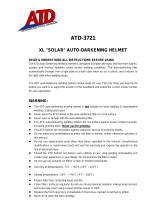
4.6.2. For conditions when there is an excess of light, which may affect the performance of the lens, turn the knob to the low setting.
5. MAINTENANCE
5.1. Changingthecartridge(Refertog.4)
5.1.1. All components clip into the rear of the helmet.
5.1.2. Pull the cartridge holder down pull the cartridge up and then down to disengage it from the top lugs.
5.1.3. Pull the black knob off the potentiometer shaft on the side off the helmet and undo the nut at the base of the shaft and remove it.
5.1.4. Push the potentiometer through into the inside of the helmet.
5.1.5. Carefully unclip the cartridge from its holder and replace.
5.1.6. Reassemble in the reverse order, ensuring that the pointer on the grinding knob is correctly orientated.
5.2. Replacing the outer protective lens cover
5.2.1. Follow steps 5.1.2. to 5.1.5.
5.2.2. Gently push the outer lens into the helmet, renew the lens, and ret the cartridge as above.
5.3. Replacing the inner protective cover lens
5.3.1. Use the recess on the top edge of the lens to pull it out and renew. Ret the lens under the clips at each side of the cassette.
5.4. Cleaning
5.4.1. Clean by wiping with a soft cloth. Clean cartridge surfaces regularly. DO NOT use solvent based cleaners. Clean sensors and solar
cells with methylated spirits using a clean cloth and wipe dry with a lint free cloth.
5.5. Replacingthebattery(Refertog.4)PartNo.PWH600.V2.03
5.5.1. When the low battery indicator light illuminates turn the battery cover anticlockwise to open it. Insert a new battery making sure that it
ts the right way up.
6. TROUBLESHOOTING
g.4
Problem Cause Solution
Irregular darkening or
dimming.
The headband may have been unevenly set on the two
sides of the helmet (unequal distances from the eyes to
the shade cartridge).
Readjust the distance of the
shade cartridge.
Shade cartridge does
not darken or ickers.
The sensors are soiled or obstructed. Clean.
Front cover lens oiled or damaged. Clean or replace.
Welding current too low. Adjust weld amps.
Poor vision. Operative lenses and/or shade cartridge soiled. Check, clean or replace.
Insufcient background lighting. Adjust light.
Slow response. Operating temperature too low. Do not use at temperatures
below -10oC (14oF).
Welding helmet slips. Headband adjustments incorrect. Refer to section 4.
Problem Cause Solution
Irregular darkening or
dimming.
The headband may have been unevenly set on the two
sides of the helmet (unequal distances from the eyes to
the shade cartridge).
Readjust the distance of the
shade cartridge.
Shade cartridge does
not darken or ickers.
The sensors are soiled or obstructed. Clean.
Front cover lens oiled or damaged. Clean or replace.
Welding current too low. Adjust weld amps.
Poor vision. Operative lenses and/or shade cartridge soiled. Check, clean or replace.
Insufcient background lighting. Adjust light.
Slow response. Operating temperature too low. Do not use at temperatures
below -10oC (14oF).
Welding helmet slips. Headband adjustments incorrect. Refer to section 4.
Original Language Version
© Jack Sealey Limited PWH600.V2 Issue 3 (2) 17/06/21











